Page 278 of 561
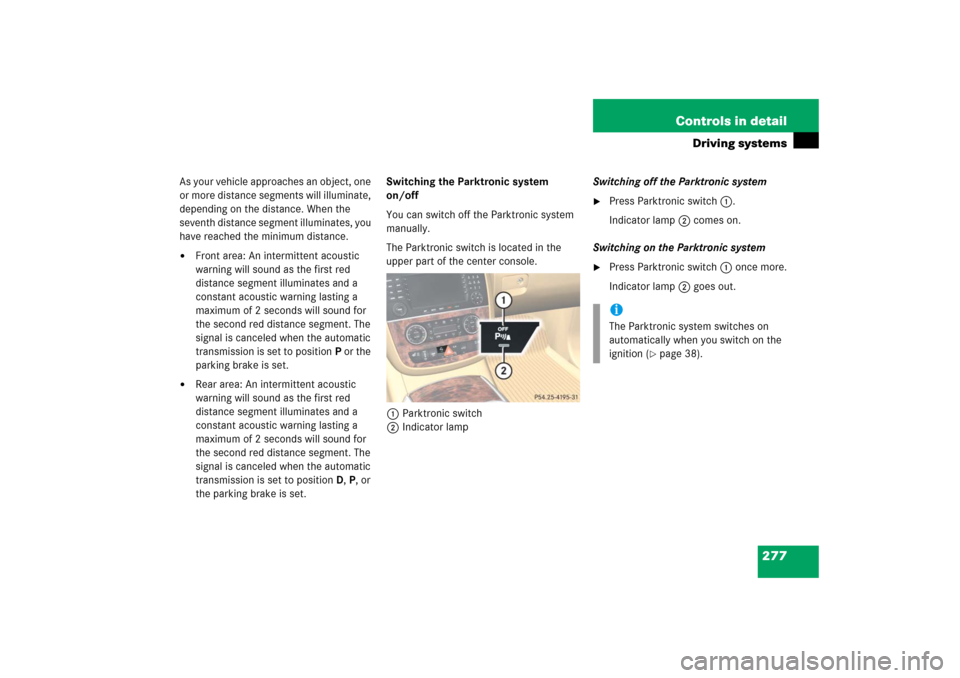
277 Controls in detail
Driving systems
As your vehicle approaches an object, one
or more distance segments will illuminate,
depending on the distance. When the
seventh distance segment illuminates, you
have reached the minimum distance.�
Front area: An intermittent acoustic
warning will sound as the first red
distance segment illuminates and a
constant acoustic warning lasting a
maximum of 2 seconds will sound for
the second red distance segment. The
signal is canceled when the automatic
transmission is set to positionP or the
parking brake is set.
�
Rear area: An intermittent acoustic
warning will sound as the first red
distance segment illuminates and a
constant acoustic warning lasting a
maximum of 2 seconds will sound for
the second red distance segment. The
signal is canceled when the automatic
transmission is set to positionD, P, or
the parking brake is set.Switching the Parktronic system
on/off
You can switch off the Parktronic system
manually.
The Parktronic switch is located in the
upper part of the center console.
1Parktronic switch
2Indicator lampSwitching off the Parktronic system
�
Press Parktronic switch1.
Indicator lamp2 comes on.
Switching on the Parktronic system
�
Press Parktronic switch1 once more.
Indicator lamp2 goes out.iThe Parktronic system switches on
automatically when you switch on the
ignition (
�page 38).
Page 280 of 561
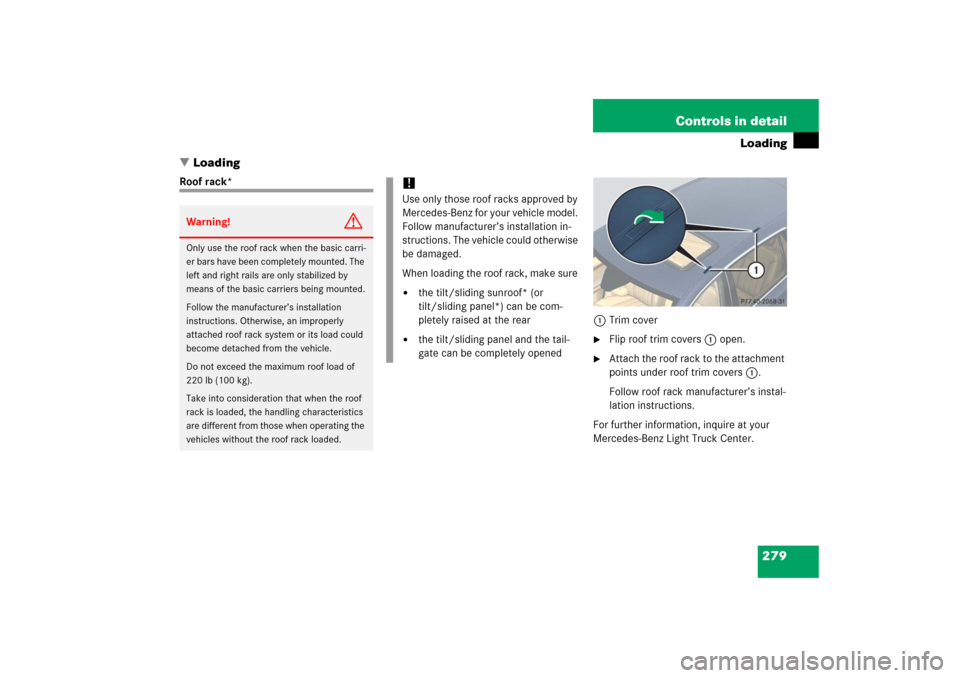
279 Controls in detail
Loading
�Loading
Roof rack*
1Trim cover
�
Flip roof trim covers 1 open.
�
Attach the roof rack to the attachment
points under roof trim covers 1.
Follow roof rack manufacturer’s instal-
lation instructions.
For further information, inquire at your
Mercedes-Benz Light Truck Center.
Warning!
G
Only use the roof rack when the basic carri-
er bars have been completely mounted. The
left and right rails are only stabilized by
means of the basic carriers being mounted.
Follow the manufacturer’s installation
instructions. Otherwise, an improperly
attached roof rack system or its load could
become detached from the vehicle.
Do not exceed the maximum roof load of
220 lb (100 kg).
Take into consideration that when the roof
rack is loaded, the handling characteristics
are different from those when operating the
vehicles without the roof rack loaded.
!Use only those roof racks approved by
Mercedes-Benz for your vehicle model.
Follow manufacturer’s installation in-
structions. The vehicle could otherwise
be damaged.
When loading the roof rack, make sure �
the tilt/sliding sunroof* (or
tilt/sliding panel*) can be com-
pletely raised at the rear
�
the tilt/sliding panel and the tail-
gate can be completely opened
Page 281 of 561
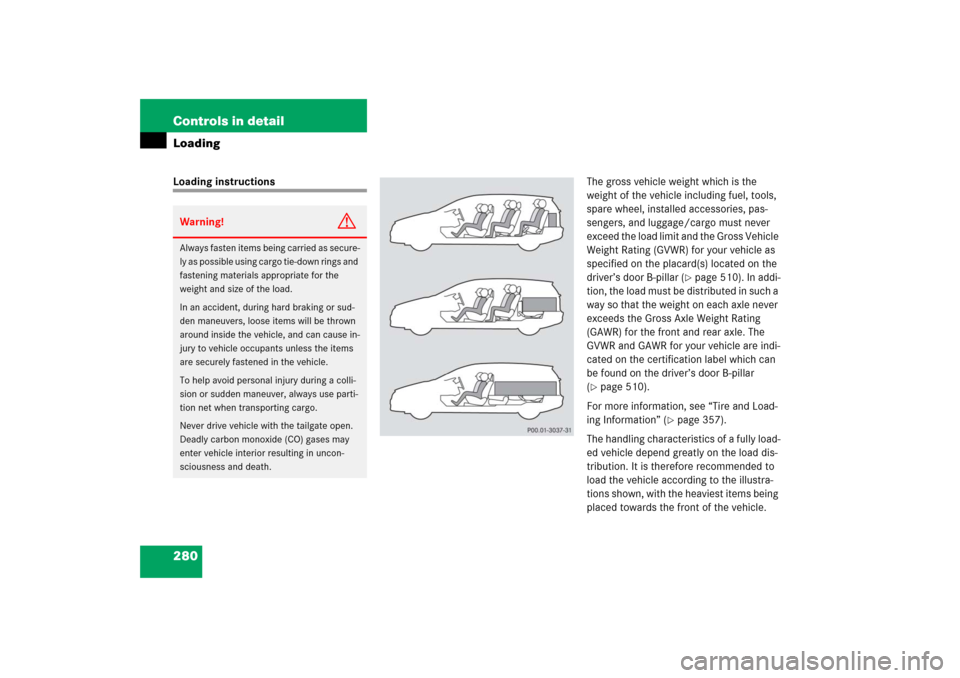
280 Controls in detailLoadingLoading instructionsThe gross vehicle weight which is the
weight of the vehicle including fuel, tools,
spare wheel, installed accessories, pas-
sengers, and luggage/cargo must never
exceed the load limit and the Gross Vehicle
Weight Rating (GVWR) for your vehicle as
specified on the placard(s) located on the
driver’s door B-pillar (
�page 510). In addi-
tion, the load must be distributed in such a
way so that the weight on each axle never
exceeds the Gross Axle Weight Rating
(GAWR) for the front and rear axle. The
GVWR and GAWR for your vehicle are indi-
cated on the certification label which can
be found on the driver’s door B-pillar
(
�page 510).
For more information, see “Tire and Load-
ing Information” (
�page 357).
The handling characteristics of a fully load-
ed vehicle depend greatly on the load dis-
tribution. It is therefore recommended to
load the vehicle according to the illustra-
tions shown, with the heaviest items being
placed towards the front of the vehicle.
Warning!
G
Always fasten items being carried as secure-
ly as possible using cargo tie-down rings and
fastening materials appropriate for the
weight and size of the load.
In an accident, during hard braking or sud-
den maneuvers, loose items will be thrown
around inside the vehicle, and can cause in-
jury to vehicle occupants unless the items
are securely fastened in the vehicle.
To help avoid personal injury during a colli-
sion or sudden maneuver, always use parti-
tion net when transporting cargo.
Never drive vehicle with the tailgate open.
Deadly carbon monoxide (CO) gases may
enter vehicle interior resulting in uncon-
sciousness and death.
Page 282 of 561
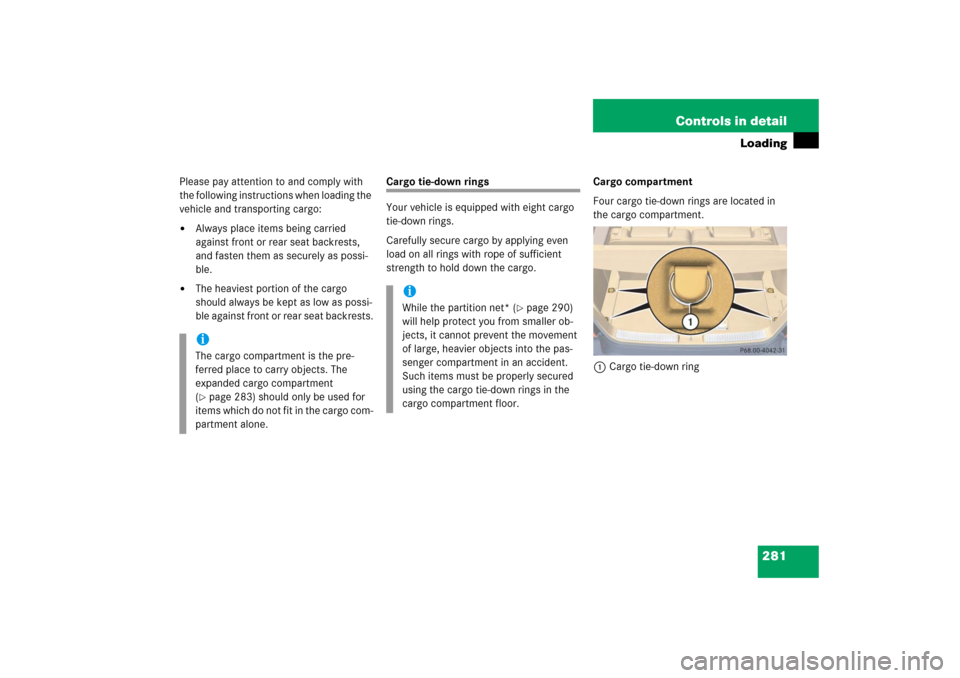
281 Controls in detail
Loading
Please pay attention to and comply with
the following instructions when loading the
vehicle and transporting cargo:�
Always place items being carried
against front or rear seat backrests,
and fasten them as securely as possi-
ble.
�
The heaviest portion of the cargo
should always be kept as low as possi-
ble against front or rear seat backrests.
Cargo tie-down rings
Your vehicle is equipped with eight cargo
tie-down rings.
Carefully secure cargo by applying even
load on all rings with rope of sufficient
strength to hold down the cargo.Cargo compartment
Four cargo tie-down rings are located in
the cargo compartment.
1Cargo tie-down ring
iThe cargo compartment is the pre-
ferred place to carry objects. The
expanded cargo compartment
(�page 283) should only be used for
items which do not fit in the cargo com-
partment alone.
iWhile the partition net* (
�page 290)
will help protect you from smaller ob-
jects, it cannot prevent the movement
of large, heavier objects into the pas-
senger compartment in an accident.
Such items must be properly secured
using the cargo tie-down rings in the
cargo compartment floor.
Page 283 of 561
282 Controls in detailLoadingSecond seat-row
Two cargo tie-down rings are located in the
footwell behind the driver’s and passenger
seat.
1Cargo tie-down ringThird seat-row
Two cargo tie-down rings are located in the
footwell behind the second-row seats.
1Cargo tie-down ring
Hooks
Two hooks are located on the rear com-
partment trim panels, one on each side.
1Hook
Use the hooks to secure light weight items
only. The maximum permissible weight per
hook is 9 lbs (4 kg).
Page 284 of 561
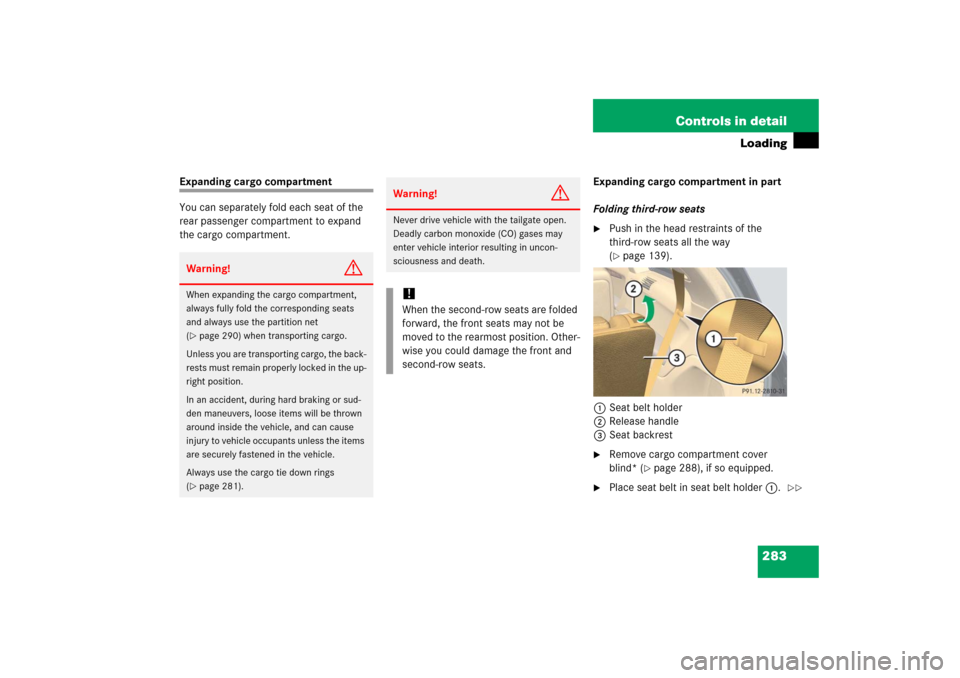
283 Controls in detail
Loading
Expanding cargo compartment
You can separately fold each seat of the
rear passenger compartment to expand
the cargo compartment.Expanding cargo compartment in part
Folding third-row seats
�
Push in the head restraints of the
third-row seats all the way
(�page 139).
1Seat belt holder
2Release handle
3Seat backrest
�
Remove cargo compartment cover
blind* (
�page 288), if so equipped.
�
Place seat belt in seat belt holder 1.
Warning!
G
When expanding the cargo compartment,
always fully fold the corresponding seats
and always use the partition net
(�page 290) when transporting cargo.
Unless you are transporting cargo, the back-
rests must remain properly locked in the up-
right position.
In an accident, during hard braking or sud-
den maneuvers, loose items will be thrown
around inside the vehicle, and can cause
injury to vehicle occupants unless the items
are securely fastened in the vehicle.
Always use the cargo tie down rings
(�page 281).
Warning!
G
Never drive vehicle with the tailgate open.
Deadly carbon monoxide (CO) gases may
enter vehicle interior resulting in uncon-
sciousness and death.!When the second-row seats are folded
forward, the front seats may not be
moved to the rearmost position. Other-
wise you could damage the front and
second-row seats.
��
Page 286 of 561
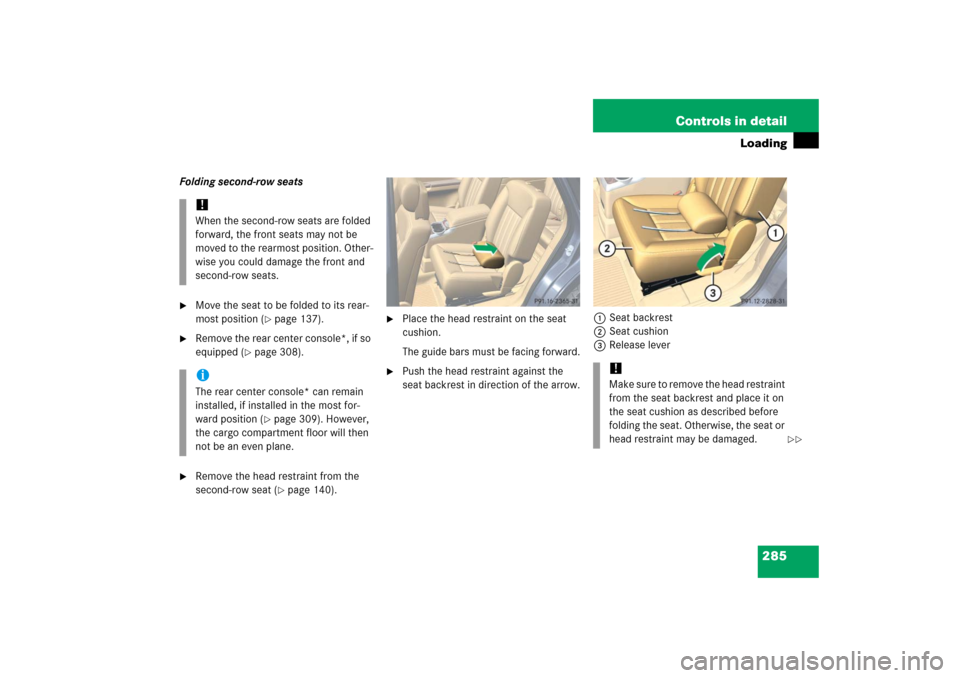
285 Controls in detail
Loading
Folding second-row seats�
Move the seat to be folded to its rear-
most position (
�page 137).
�
Remove the rear center console*, if so
equipped (
�page 308).
�
Remove the head restraint from the
second-row seat (
�page 140).
�
Place the head restraint on the seat
cushion.
The guide bars must be facing forward.
�
Push the head restraint against the
seat backrest in direction of the arrow.1Seat backrest
2Seat cushion
3Release lever
!When the second-row seats are folded
forward, the front seats may not be
moved to the rearmost position. Other-
wise you could damage the front and
second-row seats.iThe rear center console* can remain
installed, if installed in the most for-
ward position (
�page 309). However,
the cargo compartment floor will then
not be an even plane.
!Make sure to remove the head restraint
from the seat backrest and place it on
the seat cushion as described before
folding the seat. Otherwise, the seat or
head restraint may be damaged.
��
Page 288 of 561
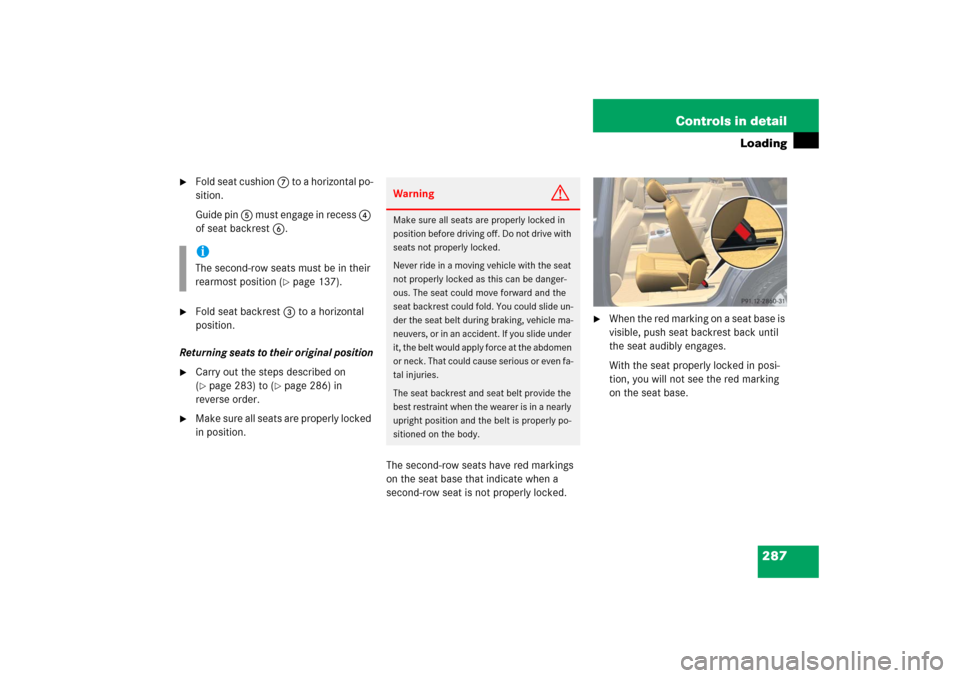
287 Controls in detail
Loading
�
Fold seat cushion 7 to a horizontal po-
sition.
Guide pin 5 must engage in recess 4
of seat backrest 6.
�
Fold seat backrest 3 to a horizontal
position.
Returning seats to their original position
�
Carry out the steps described on
(�page 283) to (
�page 286) in
reverse order.
�
Make sure all seats are properly locked
in position.
The second-row seats have red markings
on the seat base that indicate when a
second-row seat is not properly locked.
�
When the red marking on a seat base is
visible, push seat backrest back until
the seat audibly engages.
With the seat properly locked in posi-
tion, you will not see the red marking
on the seat base.
iThe second-row seats must be in their
rearmost position (
�page 137).
Warning
G
Make sure all seats are properly locked in
position before driving off. Do not drive with
seats not properly locked.
Never ride in a moving vehicle with the seat
not properly locked as this can be danger-
ous. The seat could move forward and the
seat backrest could fold. You could slide un-
der the seat belt during braking, vehicle ma-
neuvers, or in an accident. If you slide under
it, the belt would apply force at the abdomen
or neck. That could cause serious or even fa-
tal injuries.
The seat backrest and seat belt provide the
best restraint when the wearer is in a nearly
upright position and the belt is properly po-
sitioned on the body.